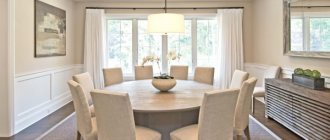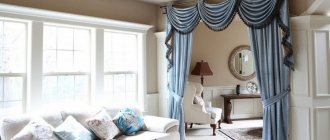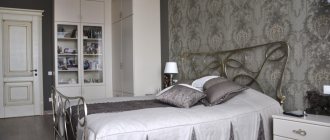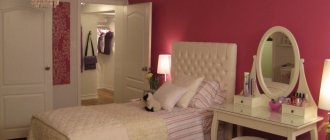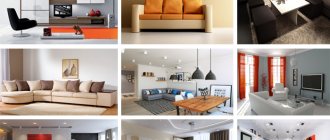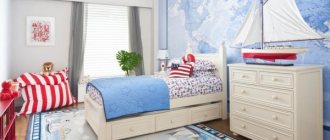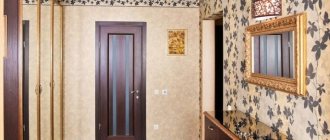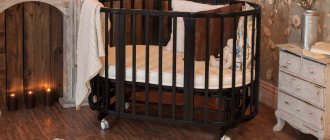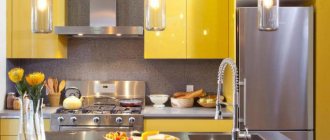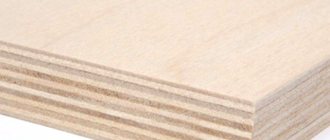The first conventional chipboards appeared back in 1918. Thanks to progress over the years, materials have become better and more reliable; moisture-resistant laminated boards are now available for the production of various products. There are many types of slabs made from wood. These include MDF and laminated chipboard with different characteristics and their own characteristics.
In order for the choice of material for your own closet or chest of drawers to be meaningful, you need to know the advantages and disadvantages of furniture materials.
Laminated particle boards based on thermosetting polymers are the main and often used material for the production of mass furnishing elements in industry, and it is also widely used in construction. Such plates are quite resistant to mechanical and chemical influences (gasoline, acetone, water, solvents, alcohol, acid, coffee and other substances). From this we can conclude that laminated chipboard is an excellent raw material for the production of medical, laboratory, educational, household and office furniture.
Due to its low cost and excellent construction properties, chipboard is the most widely used material for the manufacture of economy-class furniture.
Laminated chipboard is a material made from natural wood. This is the same chipboard, but sanded whiter, with a durable melamine film on the surface. That is, their main difference is the coating. When it is pressed into the structure of the board itself, it makes it more moisture resistant and much stronger. This is a “loose” raw material, its cost is budget, and in terms of design, due to the film and coating, it is possible to achieve various color schemes, including those with natural wood patterns. It is widely used in the production of cabinet products for the kitchen, office, home, and other home interior items as the main material. Stands for exhibitions, furniture for the interior of shops, pharmacies and supermarkets are made from it. The same thing happens with MDF, but such boards are more expensive.
Most office furniture is made from chipboard.
Lamination of chipboard boards is carried out in various colors and different textures:
fantasy vector decors;
- geometry;
- ornaments;
- plain papers;
- drawings and wood imitation.
However, this material also has its disadvantages - harmful formaldehyde emissions.
The decorative film for cladding is impregnated with resin; it is made of special decorative paper with a density of 60-90 g/m2.
Lamination is the process of applying a decorative coating under pressure and temperature.
Lamination takes place in a press. During the pressing process, the paper becomes denser; its properties are on par with plastic. A dense glossy film is formed on top, and the same film is formed on the bottom, but with a different structure - adhesive. The coating of laminated boards is quite durable and is formed due to the spreading of resin over the entire surface of the chipboard at a pressure of 25-28 MPa and a temperature of 140-210°C. For production, their width cannot be less than 10 mm, but not more than 22 mm. When laminating a chipboard, aldehyde vapors, which are harmful to the environment, are not released.
Lamination is considered a more reliable and expensive method of making chipboard.
It is pressed into the structure of the slab, making it more durable and moisture resistant.
Manufacturers label the structure of laminated chipboard differently, but usually like this:
- BS is office;
- SE – wood with surface pores;
- SM - smooth surface;
- MAT - matte smooth surface;
- PR – porous structure;
- PE – “orange peel”.
Regardless of the application method, such chipboard is called melamine-coated chipboard.
For production, the first two are most often used: BS and SE. PR is also popular, but is used less frequently; SM is used in the production of internal partitions. Other markings may occur.
Widely used for making furniture, filling coupe doors and other interior decoration elements.
Advantages and disadvantages of laminated chipboard in furniture
To choose good raw materials for specific furniture, you need to know its features, including its pros and cons. Any chipboard material is made from sawdust and wood shavings impregnated with formaldehyde resin as a binder. Chipboard emit formaldehyde, which is bad for the environment and human health, but laminated chipboard has a protective film - a laminated layer that prevents the substance from evaporating from the boards.
A variety of colors and textures, imitation of the texture of natural wood.
This is not plastic, not iron, but the same familiar wood.
To make laminated film, paper of a certain texture and pattern is used. It is impregnated with melamine resin, as a result of which it becomes a certain level of rigidity and more friable. Then, under a press, the surface of the board is combined with the film - this is how a laminated sheet of standard thickness is formed.
Resistance to mechanical damage.
Laminated chipboard is a fairly resistant material to mechanical and thermal influences with a wide range of textures and colors. It can be developed in the form of a valuable wood species. Due to its resistance to high temperatures, hot dishes can be placed on countertops made from this raw material.
Resistant to thermal influences (to hot coffee pots and frying pans).
Laminated chipboards are materials made from natural wood.
The disadvantages include the lack of fine processing and the presence of formaldehyde resins in the chipboard composition, while the advantages are high mechanical and chemical resistance.
LDSP is a representative of the old well-known chipboards (chipboards) in a more polished form.
Advantages and disadvantages
The pros and cons of the material depend on its application and price. For example, more expensive MDF panels with water-repellent laminated film are used in expensive furniture sets for both the kitchen and bathroom. The product is not afraid of water, its structure is denser, which allows it to be used for various purposes. Accordingly, the price of such a canvas will be higher than a similar product of low density and coarse grain. In general, the advantages and disadvantages depend on the type of material; MDF and chipboard have different quality characteristics.
A budget material made from coarse wood shavings. The advantages of the material are its price; it is literally the cheapest option for repairing or making furniture. But you shouldn’t expect high performance indicators. The meaning of this abbreviated designation is particle boards. Due to the absence of a laminated layer, chipboard does not withstand prolonged exposure to moisture; the material also reacts negatively to temperature changes and exposure to direct sunlight. After a short period of operation, the slab may become deformed or even break.
There are two types of chipboard: E1 and E2. The first is safe due to lower formaldehyde emissions. The second type is prohibited from being used for the production of children's furniture.
MDF furniture - what is it?
MDF is an improved technology for the production of chipboard materials. The board consists of small compressed fractions of sawdust. Thanks to this method of fastening, the material is highly durable, homogeneous and harmless to health. Thanks to these indicators, it can be used for the production of any furniture, including for a children's room. Its cost is slightly higher.
The main difference between laminated chipboard and chipboard is the coating. It is pressed into the structure of the slab, making it more durable and moisture resistant.
The main advantages are the high strength of the slabs, uniformity, ease of processing, moisture resistance, anti-deformation abilities, a wide range and beautiful design.
MDF is a fairly dense material - this makes it indispensable in the production of furniture that requires turning graceful lines, roundness, etc.
Cons: high price, boards are susceptible to mechanical damage and shock, and are easily flammable.
MDF is an environmentally friendly material and has no restrictions on its use.
MDF, what is it?
I can say with confidence that this is a high-quality and durable material that will serve you for a very long time.
MDF is made from fine sawdust. Wood waste is used to create it. To begin with, the waste is ground into small cubes, so-called “chips,” and exposed to steam and high pressure. Immediately after processing, it must be dried and glued using environmentally friendly paraffin or lignin.
Products made from wood-fiber tiles can be installed in rooms with higher humidity, unlike wooden ones, they will not warp, and their geometric dimensions will remain constant for a long time. You can be sure that the product will serve you for many years.
The smooth, dense and even surface is easy to process and is used for making various furniture, for example, in the bedroom, kitchen, nursery or hallway. In addition, laminated floors, moldings, and doors are made from wood fiber.
How to choose the right chipboard?
Today there are a considerable number of chipboards for various purposes. Their differences lie in thickness, composition, wear resistance, and density. Such features are associated with use in different areas of plate production. There is a stereotype about the density of the slab. It is believed that the denser it is, the better. But it is not so. The advantage of these boards is the low-cost raw materials (low-grade wood). This includes “thin gauges”, slabs, slats. The main thing is that these materials meet the following standards.
- Chip fractions should not be small.
- The cross-section of the chips should be square and petal-shaped. If these requirements are violated, the physical and chemical properties of the finished slab will deteriorate (bending and resistance will suffer).
Laminated chipboard has a wide range of colors, which is widely used in the production of cabinet furniture.
Consumers often ask questions: what kind of material is this for a bed - MDF? What is the difference between MDF and laminated chipboard for furniture? Let's consider these nuances in more detail.
The film is paper impregnated with melamine resins, which is why you can often find the term “melamine board”.
Advantages of chipboard:
- low price;
- does not dry out, does not flake, does not mold;
- thanks to chemical additives, bugs do not live in the stove;
- service life more than 10 years.
Pros of MDF:
- reasonable price for consumers with average incomes;
- strength;
- moisture resistance;
- includes all of the above advantages of chipboard.
Laminated chipboard can be washed and cleaned - it is moisture resistant.
The choice of material depends on what you plan to make. Laminated chipboard can be used in the manufacture of furniture intended for offices, homes, shops, and supermarkets. MDF is better to choose for children's furniture.
He is also not afraid of high temperatures.
The production of fibreboards allows us to produce products at affordable prices for various interiors. Thanks to MDF and laminated chipboard furniture, every home will be filled with coziness, warmth and comfort.
Its advantage, in addition to all of the above, is its excellent ability to imitate various textures, most often imitation of wood texture.
Pay attention to the standards for formaldehyde content in cabinet furniture.
Choosing a facade is a responsible matter. The durability of kitchen furniture, its appearance and the ability to decide on a furniture arrangement plan depend on this. Modern designers prefer the following materials for the manufacture of kitchen facades: MDF (fine fraction), laminated chipboard (laminated chipboard) and plastic. These materials have proven themselves highly, both in terms of cost-effective indicators and aesthetic characteristics. Thanks to modern production technologies, each of these types of finishes can be produced in any shape of furniture.
Numerous reviews on the Internet about the material for the kitchen facade demonstrate that users do not give preference to any type of kitchen; they are all in an equal position. Therefore, in order to make the final choice of material, you should familiarize yourself with the advantages and disadvantages of each type of kitchen.
MDF or chipboard: what to choose
The comparative characteristics of the two materials are approximately the same. Sheets of particleboard panels can be easily processed with various tools, and without additional processing, they are highly resistant to microorganisms. But these properties are also characteristic of products made from the finely dispersed fraction.
The resistance to humidity of both materials directly depends on the type of coating and processing of the ends of the products. However, the fire hazard coefficient is the same, and belongs to category G4 - highly flammable substances. The density of the slabs is on average equal to 0.5-0.8 tons per cubic meter.
However, materials made from MDF sheets, thanks to the latest production technologies, benefit in panel thickness and flexibility. It is impossible to find chipboard slabs 3 mm thick on sale, and those available are very bending resistant. Fine products are distinguished by a wider range of models offered.
In terms of price value, panels made from wood-based particle boards undoubtedly occupy a leading position.
Chipboard, like MDF, contains harmful resins used in manufacturing. But, according to manufacturers of finely dispersed products, their products contain less such resins.
The difficulty of choosing is explained by the fact that MDF panels are a more technologically advanced version of chipboard boards. But which of the presented materials to choose depends largely on the budget and personal preferences of the buyer.
Characteristics of MDF, its advantages and disadvantages
MDF facades have been the most popular and widespread in the world for more than ten years. These kitchens are painted like cars. Paint is applied to the surface of the facades in several layers, each subsequent one, after the previous one has dried, before which the surface of the material is thoroughly primed. After the paint has completely dried, the MDF is coated with a protective layer of varnish.
MDF kitchens are the most popular on the market
Such kitchens have a number of advantages:
- affordable price compared to more modern types of facades;
- the possibility of obtaining facades of any color and texture: glossy, matte, chameleon, etc.;
- kitchens made of MDF are not afraid of moisture, high temperatures and chemical exposure;
- quite unpretentious in care, do not require special means;
- variety of façade shapes: flat or curved;
- facades can withstand up to four paintings;
- resistant to moisture and odors.
But MDF kitchens are not without their drawbacks, including:
- loss of brightness and color saturation under the influence of ultraviolet radiation;
- the surface is easily chipped and scratched;
- If the surface of the facade is damaged, it is impossible to carry out partial painting, since it is difficult to choose a shade.
Advice. If, nevertheless, scratches appear on the MDF facade, it is not necessary to repaint it entirely; you can come up with an original pattern and apply it to the entire perimeter of the facades, thereby obtaining a completely new interior.
Kitchens made of MDF look quite simple, so it would be more original to combine several colors in the facades and add curved lines on drawers or side cabinets, so the kitchen will look like a designer one.
What is chipboard?
Everyone knows what it is, but let's see how it is made. Chipboard is a material that can be obtained by pressing particles mixed with synthetic resins. In this case, they take low-value wood (shavings, sawdust) of different species.
Chipboard panels can be used for interior decoration, as well as for construction, for example, roofs, partitions and other structures. Here is an example of using chipboard for the kitchen.
Due to its low price, chipboard is often used for inexpensive office furniture.
But the formaldehyde resins used to glue the chips evaporate in small quantities into the air, polluting it.
You need to be able to distinguish between two types of particle boards. The first (E1) is less toxic, as it emits noticeably less fumes into the air. But E2 should not be used in the manufacture of children's beds.
The edges of such a product must have a special coating to prevent air pollution; it is important that the protection is without damage.
Laminated chipboard is a beautiful type of particle board. A durable coating on the surface is formed when the resin spreads under the influence of temperature and pressure.
Laminated chipboard - looks very beautiful thanks to the various patterns imitating natural wood.
Characteristics of laminated chipboard, its advantages and disadvantages
This type of kitchen facade is no less popular than MDF, but it is more often chosen for use in a rented apartment, country house, or as a temporary option. Laminated chipboard is produced using a physical and chemical lamination process, during which a film is applied to a sheet of chipboard. The result is a smooth surface with a slight reflective effect. The advantages of this method include the following:
- cheap type of finishing in comparison with any other kitchen facades.
This is the only advantage of this material.
In addition, the material has a number of disadvantages:
- low strength of facades, both film and chipboard are easily scratched;
- low water resistance, especially at corners; after a year, the facades can already delaminate and begin to come apart;
- due to deformations of the material, the fittings also fail, doors may creak, or not fully open or close;
- very short service life due to low quality material;
- low resistance to moisture and odors;
- Maintenance of facades is too demanding, the film is easily damaged.
Attention! If you decide to buy a kitchen made of laminated chipboard, plan the top tier of drawers so that they are no less than 65-70 cm from the surface of the countertop, or even better, place them as far as possible from the hob. In this way you will minimize the impact of steam on the façade and extend its service life.
Disadvantages of MDF panels:
Limited design options
Typically, the design of walls or ceilings made of MDF panels comes down to the choice of texture and color of the panels. However, there is always the opportunity to play with colors:
And besides, MDF panels can be used to sheathe not only smooth walls or partitions, but also to make quite complex structures and even make some imitation of arched ceilings. So the above limitation is not even a disadvantage, but in a sense an advantage of MDF panels, if you know how to use it correctly.
Reducing the usable volume of the room
As a rule, MDF panels are mounted on a frame that is not at all ethereal, but takes away several thousand required cubic centimeters from the volume of the room. For example, when finishing a room measuring 5x4 m with a height of 2.5 m, even if the width of the timber used is 2 cm, the volume of the room will still decrease by more than 1 m3, because the panels also have a thickness of about 1 cm, which means the total reduction in volume will be approximately :
(4 + 5) 2 2.5 (0.02 + 0.01) = 1.35 m3
However, this is a common drawback when using finishing materials sewn onto the frame. For large apartments this is not of fundamental importance, but in small apartments every square and cubic centimeter counts.
Low fire resistance
MDF panels are flammable material and this must be taken into account. And when installing sockets and switches on walls trimmed with MDF panels, it is advisable to use metal socket boxes.
Low water resistance
In case of direct contact with water and even when condensation settles, which can happen if the walls on an insulated loggia or balcony are covered with panels, MDF panels swell and lose their attractive appearance. This is especially critical for external and internal corners.
Low strength laminate
The MDF panels themselves are not much different from the fiberboard that has long been known to local consumers. The main highlight is the laminating layer on which the corresponding pattern is applied. However, the lamination layer is too strong a name for a thin layer of paper. It is not difficult to damage the laminating layer, but restoring it is a difficult task, so wall decoration with MDF panels sometimes has to be changed every 3-5 years, like wallpaper. Nevertheless, for offices and various kinds of official institutions, wall decoration with MDF panels is one of the best options.
Characteristics of plastic facades, their advantages and disadvantages
Plastic facades are only gaining momentum in popularity. Despite the fact that the name “kitchen made of plastic” has taken root among people, this is a little incorrect. Such facades are made using two technologies: according to the first method, plastic is glued to MDF, according to the second, plastic is glued to chipboard. Both methods are reliable and of high quality, but, as discussed earlier, MDF facades will be more expensive. A plastic kitchen has a number of advantages, including:
- wide palette of colors;
- attractive and expensive appearance of the kitchen;
- facades are resistant to high temperatures;
- You can use abrasives for maintenance; there will be no micro-scratches left on the surface;
- do not fade in the sun;
- resistant to moisture and odors.
- long service life, without loss of appearance.
A significant list of advantages of plastic kitchens does not deprive them of disadvantages:
- the high cost of plastic facades, but over a long service life it is justified;
- Only straight parts can be made; bends and semicircles are impossible;
- demanding to maintain, every fingerprint is visible on the surface of the facades.
Advice. If you have chosen a kitchen with plastic facades, it is better to opt for glossy surfaces; they retain an attractive appearance longer, while matte facades are more difficult to clean and very quickly take on the appearance of shabby and unkempt.
Recently, many craftsmen have been trying to mislead the client and pass off laminated chipboard as plastic. To distinguish plastic from laminated chipboard, just look closely at their reflection: plastic reflects everything specularly, while on laminated chipboard there is a slight areole around the reflection.
MDF
Production technology: produced in the same way as chipboard, but using smaller wood particles - less than 1 mm. The standard thickness of MDF sheet is from 1.8 to 50 mm.
| Advantages: | Flaws: |
| + Possibility of applying patterns and other additional processing | — Low strength |
| + Moisture resistance | - Vulnerability to high temperatures |
| + Protection against fungus |
MDF boards
What material to choose for the kitchen?
Before deciding which material is best to choose for making a kitchen, you need to decide what service life you want to get as a result. It’s worth choosing laminated chipboard if you have a very limited budget and are planning a major renovation in a few years. As for plastic and MDF, depending on your financial capabilities, you can make any choice of kitchen material. Both of these materials are of high quality and have a long service life.
Choosing a material for making a kitchen is only the surface of the iceberg; it is important to properly plan work areas of sufficient size and in the required quantity. A photo found on the Internet will not necessarily be possible to bring to life in your kitchen. Therefore, it is better to seek help from a professional designer who will help you usefully distribute the space.
What are the differences between them?
Although the tiles are used in almost the same way, there are significant differences that everyone should know.
- The main difference between them is in the manufacturing technologies and materials used. If particle boards are made from various types of wood raw materials, using temperature and high pressure, then MDF is made from wood waste, using pressure, temperature and, of course, steam.
- Formaldehyde (synthetic) resins are used to bind chipboard particles; in this respect, the materials are similar, but the resin content per cubic meter of MDF board is usually higher, due to the fact that the density of this board is on average 100 kg higher. That is why the harmfulness of MDF may be higher.
- Fiber boards are much more expensive than particle boards, but their quality is much better.
- The choice lies ahead, either quality and high price, or practicality in use, but the product itself is much cheaper.
What material your furniture will be made of is up to you to decide.
Which kitchen facades to choose - video
When buying furniture, an unprepared person can get confused. Beautiful facades of various colors and shapes and completely incomprehensible terms: MDF, laminated chipboard. What is it and what is furniture made from? Today, a wide variety of materials are used in furniture production. But most often cabinet furniture is made from chipboard (chipboard) or MDF. It’s hard to say what’s better. You need to understand how they differ.
But they differ in manufacturing technology. Both materials consist of waste wood processing. Both chipboard and MDF are compressed wood shavings and sawdust
. The only difference is in the method of gluing the elements. Despite this seemingly insignificant difference, MDF and chipboard are quite different from each other.
Generalization on the topic
When deciding which material is best suited for the manufacture of kitchen sets, it is necessary to take into account the long-term use of the furniture. For a temporary kitchen, it is better to choose laminated chipboard (rather than chipboard). The laminated surface will protect the base from moisture and high temperatures. If the kitchen is being made for personal use, if you want to forget about its refurbishment over the next ten years, we choose MDF for the manufacture of the furniture and allocate a larger budget for this. The high costs will be fully compensated by the safety, durability and high decorative qualities of the new headset.
Read also: Step-by-step instructions for attaching wall cabinets in the kitchen
And lastly, the furniture should be made of practical material; it will be easier to care for MDF than laminated chipboard. Whatever is chosen, both materials successfully imitate solid wood, so the kitchen will look decent in any case.
What is laminated chipboard? Pros and cons
Chipboard, what is it? This is a particle board made by pressing wood elements with formaldehyde resin. After manufacturing, the slab is covered with a special polymer film.
This material is used to create any economy class cabinet furniture.
Advantages of laminated chipboard:
- Variety of colors. The surface of laminated chipboard can be of any color, matte or glossy.
- Easy care. Furniture and this material can simply be wiped with a damp cloth.
- Durability. With proper care and compliance with operating rules, such furniture will last for many years.
- Price. The advantage of laminated chipboard is, first of all, low price with good quality.
Disadvantages of laminated chipboard:
- Chipboard is afraid of moisture.
- Reacts poorly to sudden temperature changes.
- Formaldehyde resins are toxic.
At first glance, it seems that laminated chipboard is not suitable for the kitchen. But that's not true. With high-quality processing of the ends, such a kitchen is perfectly preserved.
Safety class
Due to the fact that the resins used in the manufacture of chipboard are quite toxic, when choosing furniture it is necessary to check the quality certificate
. There are several security classes:
- E0. This is the safest furniture, the admixtures of harmful substances are kept to a minimum. This furniture is suitable for children's rooms. It is also used in medical institutions. Unfortunately, there is no furniture production of this class in Russia.
- E1. Furniture of this class is produced by domestic manufacturers. The content of harmful resins is low and does not harm health.
- E2 and E3. The manufacture of furniture from laminated chipboard of this class for residential premises is prohibited in Europe. Russia does not have such a ban. The production of children's furniture from such chipboard is prohibited in Russia.
What is MDF and chipboard
Chipboard (chipboard) is made by hot pressing chips together with synthetic resins. Smaller particles, in other words, sawdust, are used to create MDF boards (the abbreviation is taken from English - medium-density fiberboard), where natural materials - lignin and paraffin - are used as a fastening element.
Therefore, if, when choosing furniture, you are wondering what is more environmentally friendly, MDF or chipboard, and are looking for a more natural option, choose MDF. It is recommended for the bedroom and nursery. If you like furniture made from chipboard, pay attention to how well the board is laminated or coated with a special product. It would be a good idea to check the quality certificate and make sure that the cabinet model, for example, can be used in residential premises (the most optimal emission level is E1).
How to distinguish what was used as a frame for old furniture - MDF or chipboard? Pay attention to the damage that used furniture probably has. The internal composition of the slab - shavings or sawdust - will immediately tell you the answer.
MDF furniture Pros and cons
MDF is the same wood chips as chipboard, pressed at high temperature and high pressure. only the binding element instead of toxic formaldehyde is paraffin or lignin. Which is much safer.
MDF is widely used due to its strength. In addition to cabinet furniture, this can be the ceiling, wall panels and even the floor.
Advantages of MDF:
- Strength. Compared to laminated chipboard, MDF is several times stronger.
- Moisture resistance. Furniture made from MDF is not afraid of moisture.
- Ability to create bent elements.
- Easy care.
- Environmental friendliness is the main advantage of MDF.
MDF is often equated to natural wood. Therefore, the price is considered the only disadvantage of this material.
MDF kitchens: characteristics, pros and possible cons
MDF boards are made by pressing tiny sawdust with the addition of paraffins, which have water-repellent properties, or lignin for bonding. A kitchen made from MDF is more environmentally friendly than similar furniture made from chipboard.
Recently, the manufacture of furniture from MDF has become increasingly popular in Europe. This is explained by the advantages that MDF boards undoubtedly have:
- Environmental Safety;
- Softness in processing;
- Long service life;
- Preservation of the properties of natural wood;
- Low production costs.
MDF, like chipboard, can be laminated, and this significantly increases its waterproof qualities.
Modern designers love to work with MDF; it is easy to process and create beautiful carved or embossed elements for furniture decoration.
New kitchens made from MDF look stylish and look completely indistinguishable from furniture made from natural wood.
The main disadvantage is the lack of a developed production base for the manufacture of MDF in Russia, therefore, for the Russian consumer, furniture made from MDF is much more expensive than analogues made from other types of boards.
For the kitchen: chipboard or MDF?
MDF kitchen
What is a kitchen? This is a humid area with temperature changes. Steam, fat, hot plate, water. For such a difficult room, it is better to choose a material that is more durable and resistant to various changes - MDF.
MDF facades come in two types:
- Covered with film
. The film version is cheaper, but there is a risk that near high temperatures the film will swell and begin to come off. - Painted MDF
. The price is higher than for film ones. Provided the correct coloring has an ideal appearance. Resistant to moisture and high temperatures. However, with a strong impact, the paint can be damaged.
An MDF kitchen can only disappoint if the manufacturer has skimped on quality. Unfortunately, this is difficult to determine visually.
Kitchen made of laminated chipboard
If, nevertheless, the choice fell on the inexpensive segment of kitchens made of laminated chipboard, then you should pay attention to some elements:
The best budget option is a combination of MDF and chipboard. In this case, the frame is made of chipboard, and the facades on which the strongest impact occurs are made of MDF.
Pros and cons of MDF
MDF (fine fraction) is wood dust boards pressed on an adhesive base. This material is very practical and, at the same time, inexpensive. Painted MDF is much more expensive, but its price corresponds to the quality. The process of applying paint occurs in several layers, which are varnished at the end of the process.
The customer can model the desired type of kitchen furniture, its shape and decide on color preference. MDF provides the opportunity to give furniture oval shapes and make sharp corners more rounded, thanks to various technologies. If you choose the painted MDF option, you can use any shade from a wide range of colors to personalize and brighten your kitchen furniture. A good option would be color synthesis.
There are several types of MDF. The painted material is distinguished by its durability. It is resistant to any external damage: excessive humidity, large amounts of dirt, scratches. Frame MDF visually creates the appearance of using different types of wood. MDF with PVC elements will perfectly protect kitchen furniture from moisture and high temperatures.
- regular MDF will be an excellent budget option;
- huge range of colors;
- relatively moisture-resistant material;
- any preferences in choosing a form are possible;
- the process of washing and wiping the surface occurs without problems;
- various coating options: varnish, matte, laminated, plastic;
- Perfect for long-term use.
- painted MDF is quite expensive;
- Any dirt or abrasions easily remain on the surface of this material;
- it quickly deteriorates from contact with high temperatures if covered with a film.
MDF has become a real breakthrough in the facade materials market. It is ideal for making kitchen furniture. MDF is an analogue of real wood, so you should not use dense materials to cover it. The most popular methods for finishing the surface of this material are PVC films and enamel.
Advice. In order for the MDF facade to last for a long time, it is better to cover it with plastic.
MDF or chipboard for the bedroom
MDF bedroom furniture
In the bedroom, the microclimate is always favorable, there are no sudden temperature changes, so the resistance of furniture to adverse influences is not so important. This is where safety comes to the fore. After all, people spend a lot of time in the bedroom. Especially when it comes to a children's room, where the child spends most of his time. It is important that the furniture is safe. MDF can have various decorative coatings:
- The plastic coating will protect the color from fading and add any texture.
- The film coating allows you to choose any color, even iridescent and chameleon.
- Veneer covering. Furniture with such a coating always looks good, because veneer is a wood material and has the texture of wood.
Bedrooms made of laminated chipboard
You shouldn’t completely write off laminated chipboard; given a certain quality, this material is not inferior to the more expensive MDF. When choosing furniture made from chipboard, you should pay attention to some nuances:
Chipboard and MDF have their advantages. Having studied the properties of these two materials, making a choice in favor of one is not so difficult. What is better MDF or chipboard for the kitchen? Only the buyer decides; the main thing is that the furniture is strong, durable and safe.
Chipboard and MDF are made from wood, so they are similar in many ways. But besides the cost, there are a number of significant differences. Only after understanding them can we conclude that in a particular situation during the construction process (repair, restoration) it is better to use chipboard or MDF. By the way, this also applies to the choice of furniture. Its strength and durability are the main evaluation criteria, since it is purchased for many years.
- Chipboard. The first two letters indicate the specificity of the raw material (wood chips). That is, the production does not use dust, as in the manufacture of some types of building materials, but rather large fractions. The last letter indicates the type of product (slab).
- MDF. The confusion in decoding is due to the fact that when displaying markings, English phraseology is written in Russian letters. In fact, this is also a board, but slightly different in structure - wood fiber. That is, the source material is subjected to more thorough grinding at the preparation stage.
To understand which of the two varieties of the same type of product is better (chipboard or MDF), you need to understand what their differences are in terms of performance characteristics. This is what determines the specific application of each sample.
laminated chipboard
In order to understand what is better to choose for the kitchen: MDF or laminated chipboard, you need to understand further and find out what the second material is made of.
What is chipboard - particle boards, which are manufactured using the following technology. Wood shavings are dried in production and then mixed with resins. The result is a mass from which slabs are formed. The surface of the plates is additionally sanded and coated with a layer of varnish. The result is a working base, which is then used during the furniture manufacturing process to assemble kitchen cabinets and internal partitions.
Recently, manufacturers have begun to produce laminated chipboards - wood fiber boards. They differ from chipboard in that during the production process sawdust is mixed with resin, and the resulting mass is formed using presses into slabs. The surface of the finished boards is laminated with paper film, which in turn is impregnated with resin made from melamine. After this treatment, the material becomes resistant to high temperatures and moisture. Paper film allows you to create surfaces of different colors; the photo printing method makes it possible to create images that imitate the surfaces of expensive types of wood or marble. Therefore, you can easily choose something most suitable for yourself. The drawings quite accurately imitate the surface of wood, and this is a definite plus in choosing laminated chipboard for the kitchen.
The described material has other advantages.
- It costs an order of magnitude cheaper than MDF.
- It can be used to make furniture cabinets.
Read also: Criteria for choosing a cabinet for an oven
There are many more disadvantages:
- Formaldehyde resins are used to glue chips; they negatively affect human health. With any increase in temperature, such material is capable of releasing toxic fumes. Inhaling them is especially dangerous.
- Laminated chipboard and chipboard for the kitchen cannot boast of high quality. The slabs should not be subjected to rough processing; if you want to make a rounded cut, the slab may simply crack.
- The slabs have an unattractive appearance, so it is not worth making kitchen facades from laminated chipboard or chipboard.
- The described material does not withstand exposure to moisture and high temperatures.
- It will take a lot of effort to keep kitchen surfaces clean.
- If it is necessary to make facades from chipboard or laminated chipboard, the surfaces of the boards must be covered with additional material, such as acrylic or plastic. This procedure increases the final cost, which eliminates the main advantage of the described slabs.
Summing up the intermediate results, we can safely say that you should not choose chipboard or laminated chipboard for the kitchen. The slabs do not comply with the operating standards of the described space. They are not suitable for high-quality furniture making. If you need to equip a kitchen in a rented apartment or house, you can allocate a small amount and make a budget set. From all that has been said, it becomes clear what is better to choose for the kitchen: MDF or chipboard.
Features of materials
All the advantages of the slabs indicated below, as well as a number of disadvantages, are the result of an analysis of reviews and an exchange of opinions on thematic forums. From the author’s point of view, they deserve more trust than information posted on the websites of dealers and manufacturers. At least, you definitely can’t call them custom-made.
Chipboard
The prepared mixture based on wood fractions (shavings, sawdust) and an adhesive composition is subjected to “hot” pressing, that is, simultaneously exposed to high pressure and temperature. And here there is one of the main differences from MDF. Wood particles vary in size and shape. In addition, there is a difference in the proportion of components and the type of glue used. Based on this, all chipboard slabs are divided into groups according to their structure density - low, medium and high. That is, the buyer has a choice according to this criterion.
Samples can consist of one or several layers (up to 5), which also diversifies their assortment.
Depending on the amount of toxic formaldehyde (one of the components of the adhesive) in the initial mixture for chipboard, the boards are divided into categories E0 (minimum percentage, which in practice is not taken into account), E1 (low content) and E2 (increased).
Pros:
- A wide range of products allows you to make the optimal choice of chipboard.
- Attractive price. Compared to MDF, with all the same parameters of the boards (dimensions, thickness), it is lower by about 30 - 35%. This is partly due to the fact that there is significant competition in this market segment, and in order to increase sales, manufacturers are forced to reduce the price of chipboard sheets.
Minuses:
- Toxicity. Perhaps this is an overly harsh definition, but it is clear that formaldehyde is present in almost all adhesives for this type of slab. Consequently, when the resin is heated, harmful fumes are released. The only difference is in their concentration (depending on the category of chipboard and local conditions).
- "Looseness" of the structure. Even if the chipboard density is maximum (820 kg/m3), repeated installation/dismantling of these boards is not recommended. After several reinstallations, the fasteners in the mounting socket gradually begin to loosen, which sharply reduces the reliability of the assembly. Therefore, it is not advisable to use chipboard for the manufacture of mobile (portable) structures. As a last resort, for the back walls of various cabinets, racks and the like, where you can drill new holes as much as you like - they will still be hidden from visual view.
- Difficulty of processing. During the cutting process, especially if the tool is chosen incorrectly, the result is not just a wide cut, but also one with fringe on the edges. Milling and cutting grooves on chipboard is not recommended at all. You will not be able to achieve high quality on your own without practical skills. This should be taken into account by those who decide to make any piece of furniture from these slabs with their own hands.
- Low bending strength. Here it is short - even high-density chipboards break quite easily (under certain conditions). Therefore, it should not be used in places exposed to dynamic influences. Only for “stationary” structural elements.
MDF
The manufacturing conditions are in many ways similar to chipboard (hot steam, pressing), but the technology is somewhat different. Wood processing waste is crushed, after which it is also wiped using special equipment. In fact, these are already microscopic fractions, a dusty mass. After drying, it is mixed with an adhesive and pressed. Therefore, there is no need to talk about any layers - MDF boards are homogeneous in their structure and have a high density (790 ± 50).
"Environmentally friendly". In the manufacture of MDF, resins containing toxic components are not used. Everything is only natural (wood fractions + adhesives based on lingin, paraffin or something similar), without “chemistry”.
Accuracy of all linear parameters. Pressing the “dust” makes it possible to almost completely eliminate deviations from the declared size. In addition, the edges and ends of the slabs are smooth, so there is no need to additionally sand the base before further finishing. The result is a partial reduction in installation (assembly) costs and time savings.
Pros:
- Ease of processing. MDF, unlike chipboard, can be milled, make various cuts, and drill. During the cutting process, there is an even cut, high accuracy and a minimum of waste.
- High strength. The result is the possibility of constructing prefabricated structures. As a material for furniture (taking into account the low cost of production), especially when making it yourself, MDF is one of the best options.
- Relative plasticity. In this parameter, these boards are superior to chipboard. With slight deformation of the structure, as well as excessive loading of the sample, the MDF will not break, but will only bend slightly (if the thickness is initially selected correctly).
- Good moisture resistance. If it will not last long in damp rooms, then MDF can be used. Especially if the plate is laminated.
Minuses:
- Flammability. Both chipboard and MDF, as wood-based materials, are susceptible to combustion. There is no escape from this. But with wood fiber boards you need to be more careful in this regard. They react more strongly to open fire. Therefore, when installing and finishing MDF, it cannot be used (in the form of gas burners or something similar). For example, when fixing self-adhesive sheets of rolled materials on such a basis.
- Low impact strength. Despite the certain plasticity of the board, a fallen heavy object leaves a dent on the MDF. It is quite difficult to eliminate such a defect. Therefore, it is better not to use these products for finishing floors.
- The cost is higher than chipboard. This limits the use of MDF in various utility rooms and so on. That is, where appearance does not play a special role, it is better to focus on chipboard of the corresponding category.
Fiberboard
According to the production method, the material is similar to MDF, the difference is that fiberboard is wet pressed. This process is cheaper, so the material cost is significantly lower. This production method does not allow the production of a thick slab. Fibreboard is used to finish the back walls of cabinets, if they are pushed up against the wall or as a base in drawers.
One side of the material is covered with a laminated film, while the other remains untouched.
Fiberboard is not intended for furniture making, only as an additional material.
As a result, we can conclude that MDF is safer for health, stronger and is available in a wide range. But its cost is much higher . Therefore, if you want to make or order kitchen furniture that will last for many years, it is better to overpay and choose MDF. Such an overpayment will be more profitable and will pay off over the years, and the appearance of the furniture will delight you for many years.
Which kitchen is better to choose solid wood or MDF (1 video)
All illustrations of this article (9 photos)
The best posts
- How to cover bathroom walls: popular options
- Cosmetic repairs: how to make an estimate yourself?
- Trends 2020: shades of blue in the interior
- Glossy or matte ceiling? [Criterias of choice]
- Pine cones are one of the best decorations for the New Year [5 cool ideas]
- What does your house smell like? Interesting aromatherapy options for your home
- [Creativity at home] New Year's decor from pine cones and needles as in Denmark
- Paper Christmas trees in an hour [mini master class]
Related article: Pillows are the highlight of your room
Conclusion
Strength
In terms of the upper limit of this parameter, when it comes to loaded structures, there is no significant difference between chipboard and MDF. However, for other purposes (less critical elements), the choice of chipboard is much wider, since the numerical expressions of this characteristic lie in a fairly large range (density value from 350 to 820 kg/m³). And since this directly affects the cost of products, competent calculation and selection of a sample of the required group allows us to talk about the possibility of optimizing costs.
Degree of edge processing
On the one hand, the finer the fractions, the smoother the surface. If we look at it from this point of view, then MDF is better. Although there are modifications of chipboard that are distinguished by their magnificent appearance. They have a designation in the abbreviation (through a dash) from the letters P-A. These slabs are sanded, so they do not need to be further processed before applying varnish or gluing.
"Ecological cleanliness"
Buyers often pay attention to the toxicity of certain building materials, and they do the right thing. This largely determines whether the product is worth using in a residential area or not. In this regard, MDF has an advantage. Such stoves, even at high temperatures (for example, in the kitchen), practically do not emit harmful components. But with chipboard you should be more careful. They are mainly used in the arrangement of various utility rooms or outbuildings (racks in garages, sheds, surface cladding, etc.). For residential - in some cases, and then, products whose labeling contains the designation of category E0 or 1.
In this case, it is recommended to organize additional protection against the release of toxins by a surface coating (film, paint and varnish compositions or something else). Moreover, all edges of the chipboard slab are processed, including its end parts (especially after cutting the sample).
It remains to add that to reduce the cost of work, it is advisable to resort to a combination of materials. That is, the visible part of the structure is made of MDF, and the part that is hidden (the back wall, internal compartment partitions, etc.) is made of chipboard. This is exactly what thrifty “home craftsmen” generally do.
Well, what exactly to choose – chipboard or MDF – should be decided based on the specifics of the application. If you take into account the costs of the slabs, all the nuances of their preparation, installation and the duration of further operation in specific conditions, then determining what is better in this case is not at all difficult.
In furniture production, the most popular materials are MDF and chipboard. Their characteristics are largely similar, but there are some differences. It is not surprising that many people, when purchasing these materials, think about how chipboard differs from MDF and which is better. To answer this question, you need to understand in more detail the qualities and production method of each of these materials.
About the dangers of furniture made from MDF
MDF arose as a further development of the dry method of fiberboard production. The abbreviation MDF is a tracing paper from the English Medium Density Fiberboard - “medium density board”. MDF production technology eliminates the use of harmful epoxy resins and phenol. Kitchen furniture is often made from this material.
The physical properties of MDF make it possible to cut round shapes out of it. It is moisture resistant and does not warp from kitchen steam. MDF boards (or “carpets”) can be covered with PVC (polyvinyl chloride) films. With film, the material costs a little more, but is much cheaper than natural wood.
In the post-Soviet space, MDF is better known as hardboard. According to Roszdravnadzor regulations, MDF is prohibited for use in residential premises without a coating. It is known that hardboard is produced from waste from furniture and woodworking plants (from scraps, sawdust, shavings, etc.).
Uncoated MDF furniture is a source of increased threat in the form of formaldehyde fumes. Using such furniture at home, you can put your health at risk. Knowing domestic manufacturers and their responsibility in relation to manufacturing technologies, it can be assumed that domestic MDF may contain not only officially declared formaldehyde, but also other equally toxic substances that are waste from the furniture industry.
Therefore, we advise you to buy wooden furniture. It is usually made from a whole block and does not contain harmful substances.
Source: fabrika-ladygina.ru
Manufacturing Features
MDF is an abbreviation that refers to the finely divided fraction of wood. This material is made from fine sawdust (almost usually logging waste. The raw materials are crushed, treated with steam, thoroughly dried and glued. So how does MDF differ from chipboard?
Chipboard is a chipboard, for the production of which sawdust of different fractions is used. They are mixed with synthetic or and pressed at high temperatures. A large number of resins negatively affects the environmental friendliness of the material. The advantage is that it is close to the density of natural solid wood.
Chipboard
Chipboard is a chipboard, the raw materials for which are sawdust, shavings, and dust. In the case of chipboard, formaldehyde resins act as a binding component. Chipboard is widely used in furniture and shows its good sides. Of course, if it meets high quality standards.
We would like to draw your attention to the edge. Chipboard is safe only in one case: if it is efficiently and seamlessly laminated (coated with film)! Only under this condition can you sleep peacefully, without fear for your health and the health of your loved ones.
Mr.Doors cannot afford to use materials hazardous to health, so our assortment contains only high-quality E1 class chipboard. This is the standard at which formaldehyde emissions are the lowest. E1 class chipboard is recommended for use in the production of furniture for children's institutions.
Chipboard usually has a laminate finish. There are also quite a lot of colors and textures. The main competitive advantage of chipboard as a material is its cost. At the same time, he looks more than presentable.
How does MDF differ from chipboard in appearance?
Many believe that these two building materials are similar not only in production, but also in appearance. This is wrong.
The fine wood fraction has the following characteristics:
- the surface of the slab is even and smooth;
When studying the section, one can note the homogeneity and fine-grained structure of the material.
It also has pronounced characteristics:
- the surface is uneven, slightly rough;
at the cut site you can see pieces of shavings and looseness of the material.
Advantages and disadvantages of MDF panels
- Completely environmentally friendly. Unlike chipboard and fibreboard, MDF does not contain chemical compounds that emit harmful substances. Formaldehyde emissions in this case approach those of natural wood;
- Low material cost. Despite the fact that MDF is generally more expensive than similar particle board materials, the cost of finishing panels based on them remains very small and looks more attractive than in the case of wood;
- Attractive appearance and varied color palette;
- The panels are laid on a pre-installed frame, which eliminates the need for wall leveling work. In addition, this approach allows wiring and other communications to be installed under the wall;
- The material has smooth geometric shapes, which simplifies installation as much as possible. The locking connection also contributes to simplicity;
- Unlike wooden panels, it does not require varnishing after installation.
Other advantages of MDF panels include the fact that insect pests are completely indifferent to them, they absorb sound well and are poor temperature conductors, which gives them the function of insulation. In addition, over time, cracks do not appear in such panels.
Traditionally, the disadvantages are the wooden nature of such panels. Like everything created on the basis of this material, these finishing elements are highly flammable, so it is not advisable to install them in rooms with a high risk of fire. Also, MDF panels are afraid of water, and in this sense they are even less preferable than solid wood. They can only be used for interior decoration, in well-heated rooms with low humidity levels. Otherwise, mold may soon form.
Differences in use in furniture production
For those who are planning to use these materials to assemble cabinets, beds or decorative interior elements, it will be useful to know how MDF differs from chipboard in furniture.
The finely dispersed fraction is easy to cut and process. The screws can be screwed in without much difficulty. Ideal in cases where curved cutting is necessary - the cut is perfectly smooth and neat. At the same time, the material is heavy and has a different color on both sides (one side is white).
Chipboard is more capricious in processing. The cuts often turn out sloppy and “torn”. When screwing in screws, chips and cracks may appear. The advantage is that the weight of the material is light and the sides are the same color.
Furniture makers are also familiar with another material - laminated chipboard. This board is essentially the same as chipboard, only slightly improved. The surface of the slabs is covered with a special facing film. This covering is made from paper and melamine resin.
The film is literally pressed into the surface of the slab and gives the finished products increased strength and protection from moisture. The only drawback of this material is its high cost.
Array
| Advantages: | Flaws: |
| + Environmental friendliness | - High price |
| + Aesthetics | — Low protection against moisture |
| + Saturates the air with a pleasant aroma | — Vulnerability to temperature changes |
| — Heavy weight | |
| — Need for special care |
Solid oak texture
